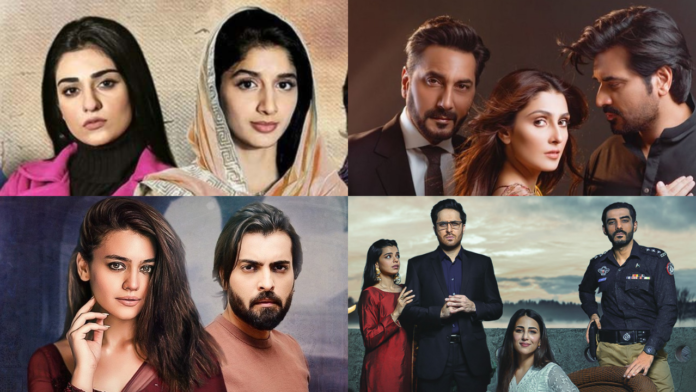Television plays a pivotal role in shaping the perception of the viewers, especially in the present information age. A huge chunk of human behaviour is impacted by the content aired in our dramas.
Over many decades, the drama industry of Pakistan has given us a wide range of genres to rejoice. However, in recent times, viewers have been annoyed by the excess of some trends. What if the writers and creators think of showing Kuch Naya? It’s high time that viewers should stop getting tortured by the same old narratives and over-the-top themes that result in misleading them.
We, at Galaxy Lollywood, have listed down some concepts that writers should get rid of ASAP:
Woman Against Woman
Since the advent of television, women are critical to almost every narrative but why are they pitted against each other? This mould never changes and is increasingly scripted in our dramas, such as ‘Sabaat’ and ‘Hum Kahan Ke Sachay Thay’.
They show female rivalry when a woman uses her power to pull another woman down. She just has one thing on her mind, Mein Uska Sukoon Barbad Kardo Gi. Showing the problem is easy but solutions go missing.
In a progressive and evolving society where women are standing up for one another, it would be more refreshing to see new stories with female characters encouraging each other.
Oppressed Bahus
Marriage and the plight of women have been a beloved subject for creators. However, its treatment has been insignificant. Women are constantly shown being oppressed by their evil in-laws.
The in-laws are the only decision-makers telling them what to do or what not to do. The titular character from ‘Durr-e-Shehwar’, Zaira from ‘Ghalati’ and Zubeida from ‘Pardes’ are prime examples of being ill-treated.
What is extremely concerning about such regressive scenes is that the common public in general not only builds up such perceptions but also adapts such stereotypes as normal.
Infidelity
The concept of infidelity is prevalent in society, but a spouse, mostly men in the shows, is involved in an extramarital affair with an Islamic justification that ‘they can marry more than once’ is overdone.
This trend has been sold well in dramas like ‘Bewafa’, ‘Mere Pass Tum Ho’, ‘Khaas’, ‘Daasi’ and ‘Dil-e-Muztar’. Adding more to the horror is the fact that the cheating spouse is forgiven and accepted back with open arms. How bizarre.
Forced Marriages
Without a doubt, the Pakistani nation is obsessed with marriages but unfortunately, writers have used this ritual only to create controversial content. There is one particular track in every drama where someone is forced to get married. Resultantly, the narrative becomes predictable for the viewers, they know the consequences will lead the couple towards divorce. To name a few, ‘Muqaddar’, ‘Gul-e-Rana’, ‘Waada’, ‘Thora Sa Haq’ and ‘Zebaish’ normalized forced Nikkah.
Sister Rivalry
It first started in ‘Maat’ and the rest followed suit. A bond that is meant to be loving and caring towards each other was horrifically portrayed. Jealousy making siblings eyeing their brothers-in-law to seek revenge. The toxic concept is difficult to comprehend.
Introvert vs Extrovert
This formula seems to have picked up pace in the run-of-the-mill list. Aima – Aiza from ‘Miraat-ul-Uroos’, Samra – Ifrah from ‘Qayamat’ and Fajr – Noor from ‘Aakhir Kab Tak’ had this thought process in common.
The introverts are ready to go beyond the jurisdictions to keep their loved ones happy, even if they are asked to marry the wrong person. On the contrary, extroverts, who are deemed bold and blunt, often take advantage of introverts.
Black Magic
Another disturbing aspect of many dramas is the presence of black magic. It is undeniable but depicting it as an alternative to achieve personal gains and ruining the lives of others is awful.
‘Nazr-e-Bad’ and ‘Dareecha’ are some of the examples that shook us to the core. The adverse effects of practising black magic are concerning. One wonders how much inspiration it has given viewers at home through this depiction over many years. Let’s not forget viewers follow dramas and the characters religiously. Why not show them something positive?
Wrong Representation of Rich and Poor
Connected to society is the absurd representation of the rich and poor. In almost every serial, the implication of a rich woman is her lavish apparel and rude behaviour. The poor, on the other hand, is the one with ordinary clothes with dupatta constantly over her head.
An example would be the drama ‘Sabaat’, where Miraal, played by Sarah Khan, comes from an elite family, hence she only wears western clothes and Mawra Hocane’s character Anaya is from a middle-class family, therefore she always wears eastern clothes and a dupatta on her head.
Final Word
There is a need for constant watch by the scriptwriters, channels and producers to put a full stop to such regressive content. The creators should evaluate the right kind of content before a drama airs at prime time. In a way, they are giving values and ideas to the masses, especially the youth, that will take a practical shape in their lives.




